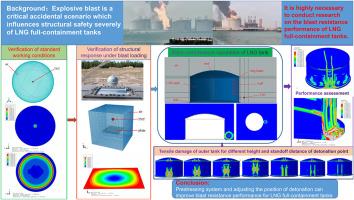Performance assessment of LNG full-containment tank under explosive blast loading
IF 4.2
3区 工程技术
Q2 ENGINEERING, CHEMICAL
Journal of Loss Prevention in The Process Industries
Pub Date : 2025-07-16
DOI:10.1016/j.jlp.2025.105735
引用次数: 0
Abstract
Explosive blast is a critical accidental scenario for liquefied natural gas (LNG) full-containment tanks, necessitating rigorous structural safety assessments. This study explored a method for evaluating the performance of LNG full-containment tanks subjected to explosive blast waves. The coupled Eulerian–Lagrangian technique in ABAQUS was used to simulate blast-wave propagation and resulting structural responses. The method was validated using empirical formulas and experimental data. A 270,000-m3 LNG full-containment tank was analyzed as a case study, and the explosion overpressure and structural responses at various locations on the tank were assessed. This study further examined the effects of detonation height and distance on tank performance using structural damage to the outer concrete wall of the tank as an evaluation indicator. Results indicated that the zone of elevated blast overpressure was primarily confined to a vertical range extending up to twice the detonation height and a horizontal angular spread of ±10° from the blast epicenter. The peak structural response of the tank was observed with a noticeable delay after the maximum explosion overpressure was applied, reflecting the tank's dynamic reaction to the sudden blast loading. The prestressing system significantly enhanced the tank blast resistance. Greater detonation heights caused more severe damage to the LNG tank and increased explosive distances reduced the damage. However, an explosion source located too low caused excessive damage to the foundation slab. Therefore, the detonation height should not be less than 0.3 times the outer wall height. These findings support safer design and risk mitigation strategies for LNG storage facilities.

爆炸荷载作用下LNG全容罐性能评价
爆炸爆炸是液化天然气(LNG)全安全壳储罐发生事故的关键场景,需要进行严格的结构安全评估。本研究探讨了LNG全容罐在爆炸冲击波作用下的性能评价方法。利用ABAQUS中的欧拉-拉格朗日耦合技术模拟了爆炸波的传播和结构响应。用经验公式和实验数据对该方法进行了验证。以一个27万m3的LNG全安全壳罐为例,对该罐不同位置的爆炸超压和结构响应进行了评估。本研究以爆轰高度和爆轰距离为评价指标,进一步考察了爆轰高度和爆轰距离对储罐性能的影响。结果表明,爆炸超压升高区主要局限于垂直范围扩大到爆高的两倍,水平角扩散距离爆炸震中±10°。在施加最大爆炸超压后,观察到储罐的峰值结构响应具有明显的延迟,反映了储罐对突然爆炸载荷的动态反应。预应力体系显著提高了储罐的抗爆破能力。更大的爆炸高度对LNG储罐造成更严重的破坏,而增加的爆炸距离减少了破坏。然而,由于爆炸源位置过低,导致了对基础板的过度破坏。因此,爆轰高度不应小于外壁高度的0.3倍。这些发现为LNG储存设施的更安全设计和风险缓解策略提供了支持。
本文章由计算机程序翻译,如有差异,请以英文原文为准。
求助全文
约1分钟内获得全文
求助全文
来源期刊
CiteScore
7.20
自引率
14.30%
发文量
226
审稿时长
52 days
期刊介绍:
The broad scope of the journal is process safety. Process safety is defined as the prevention and mitigation of process-related injuries and damage arising from process incidents involving fire, explosion and toxic release. Such undesired events occur in the process industries during the use, storage, manufacture, handling, and transportation of highly hazardous chemicals.

 求助内容:
求助内容: 应助结果提醒方式:
应助结果提醒方式:


